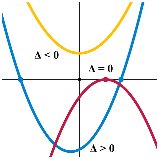|
|
|
|
|
|||||||||||
|
|
|||||||||||||||
UNIT 2 : FUNCTIONS
LESSON 6: STRETCHES & COMPRESSIONS
1.
Vertical Stretches and Compressions:
Example
1: Given the graph of
y = f(x)
as shown [blue], draw the graphs of y = 4f(x),
and y = ½ f(x)

Solution:
The
required graph of y = 4f(x) will be a vertical stretch factor 4 and may be
represented in mapping form:
(x, y)
---------------------------(x, 4y)
(Now
take key points on the graph of y = f(x) -- {(-5, 1), (-3, 1), (-1, 3),(0,1.5),
(1, 0), (3, 2)} and multiply the y-coordinates by 4.

(x, y) ----------------------------à(x, 4y)
(-5,
1) ---------------------------à(-5, 4)
(-3,
1) ---------------------------à(-3, 4)
(-1,
3) ---------------------------à(-1, 12)
(1,
0) ----------------------------à(1, 0)
(3,
2) ----------------------------à(3, 8) [see red graph at left]
The
required graph of y = ½ f(x) will be a vertical compression factor ½ and may be
represented in mapping form:
(x, y)
---------------------------(x, ½ y)
(Now
take key points on the graph of y = f(x) -- {(-5, 1), (-3, 1), (-1, 3),(0,1.5),
(1, 0), (3, 2)} and multiply the y-coordinates by ½ or 0.5
(x, y) ----------------------------à(x, ½ y) or (x, 0.5y)
(-5, 1) ---------------------------à(-5, 0.5)
(-3, 1) ---------------------------à(-3, 0.5)
(-1, 3) ---------------------------à(-1, 1.5)
(1, 0) ----------------------------à(1, 0)
(3, 2) ----------------------------à(3, 1) [see green graph above left]
Example
2: Given the graph of
y = x2 as shown, draw the graphs of y = 3f(x), and y =
½ f(x)

Solution:
The
required graph of y = 3f(x) will be a vertical stretch factor 3 and may be represented
in mapping form:
(x, y)
---------------------------(x, 3y)
(Now
take key points on the graph of y = x2 -- {(-2, 4), (-1, 1), (0, 0), (1, 1),
(2, 4)} and multiply the y-coordinates by 3.

(x, y) ----------------------------à(x, 3y)
(-2,
4) ---------------------------à(-2, 12)
(-1,
1) ---------------------------à(-1, 3)
(0,
0) ----------------------------à(0, 0)
(1,
1) ----------------------------à(1, 3)
(2,
4) ----------------------------à(2, 12) [see red graph y = 3x2 at left]
The
required graph of y = ½ f(x) will be a vertical compression factor ½ and may be represented in mapping
form:
(x, y)
---------------------------(x, ½ y)
(Now
take key points on the graph of y = x2 -- {(-2, 4), (-1, 1), (0, 0), (1, 1),
(2, 4)} and multiply the y-coordinates by ½ or 0.5
(x, y) -----------------------------à(x, 3y)
(-2, 4) ---------------------------à(-2, 2)
(-1, 1) ---------------------------à(-1, 0.5)
(0, 0) ----------------------------à(0, 0)
(1, 1) ----------------------------à(1, 0.5)
(2, 4) ----------------------------à(2, 2) [see green graph y = ½ x2
above left]
.
In summary, if
k is an integer: The graph of kf(x) will
be a vertical
stretch of factor k and the graph of 1/k
f(x) will be a vertical compression of factor 1/k
2.
Horizontal Stretches and Compressions:
Example
3: Given the graph of
y = f(x)
as shown [blue], draw the graphs of y = f(2x),
and y = f(1/2 x)

Solution: For
f(2x), complete the table of values below; when
x = -2.5, 2x will be –5 and read the
value for
f(-5) from the blue graph. Here f(-5) = 1.

|
x |
2x |
f(2x) |
|
-2.5 |
-5 |
1 |
|
-2 |
-4 |
1 |
|
-1.5 |
-3 |
1 |
|
-1 |
-2 |
2 |
|
-0.5 |
-1 |
3 |
|
0.5 |
1 |
0 |
|
1 |
2 |
1 |
|
1.5 |
3 |
2 |
Yielding
the ordered pairs for f(2x) : {(-2.5, 1), (-2, 1), (-1.5, 1), (-1, 2),
(-0.5, 3), (0.5, 0), (1, 1) (1.5, 2)} and graph above [red]
Note
that the required graph of y = f(2x) [red] will be a horizontal compression factor ½ of the graph of f(x) [blue]
and may be represented in mapping form:
(x, y)
-------------------------à (1/2 x, y) or (0.5x, y)
For f(1/2 x), complete
the table of values below;

|
x |
½
x |
f(½
x) |
|
-10 |
-5 |
1 |
|
-6 |
-3 |
1 |
|
-2 |
-1 |
3 |
|
2 |
1 |
0 |
|
4 |
2 |
1 |
|
6 |
3 |
2 |
Yielding
the ordered pairs for
f(½ x) : {(-10, 1), (-6,
1), (-2, 3), (2, 0), (4, 1), (6, 2)} and graph above [green]
Note
that the required graph of y = f(½ x) [green] will be a horizontal
stretch factor 2 of the graph of f(x) [blue]
and may be represented in mapping form:
(x, y)
-------------------------à (2x, y) In summary, if
k is an integer: The graph of f(kx) will be
a horizontal compression of factor
1/k and the graph of f(1/k
x) will be a horizontal stretch of factor k



